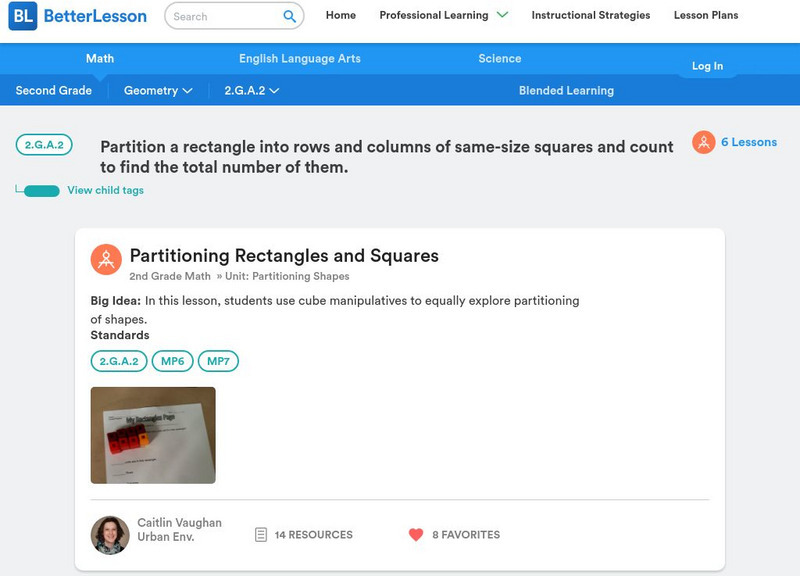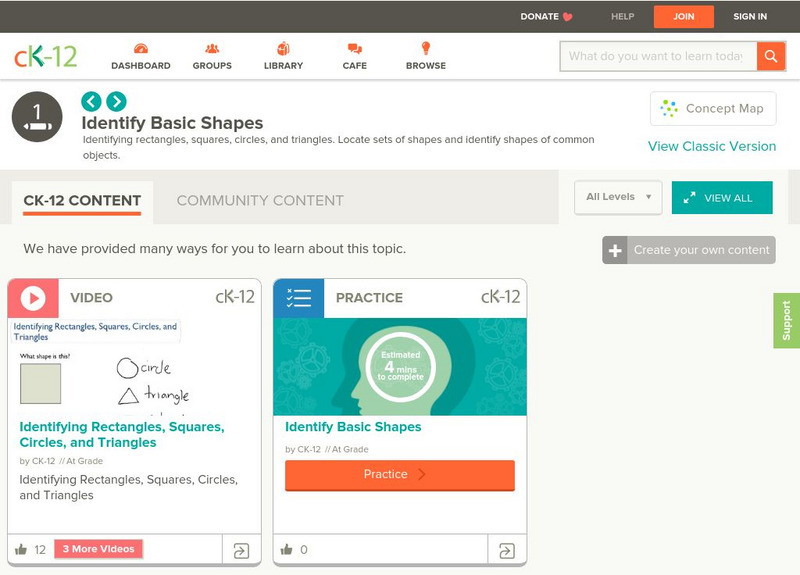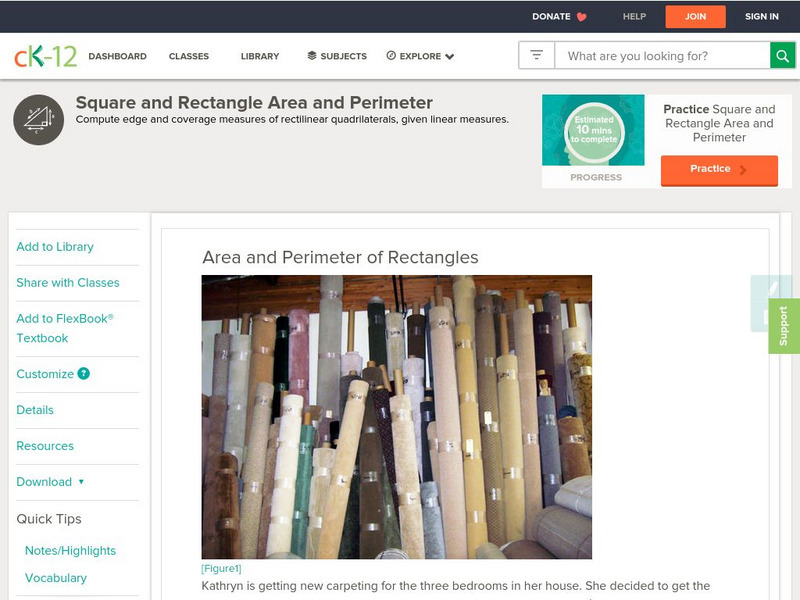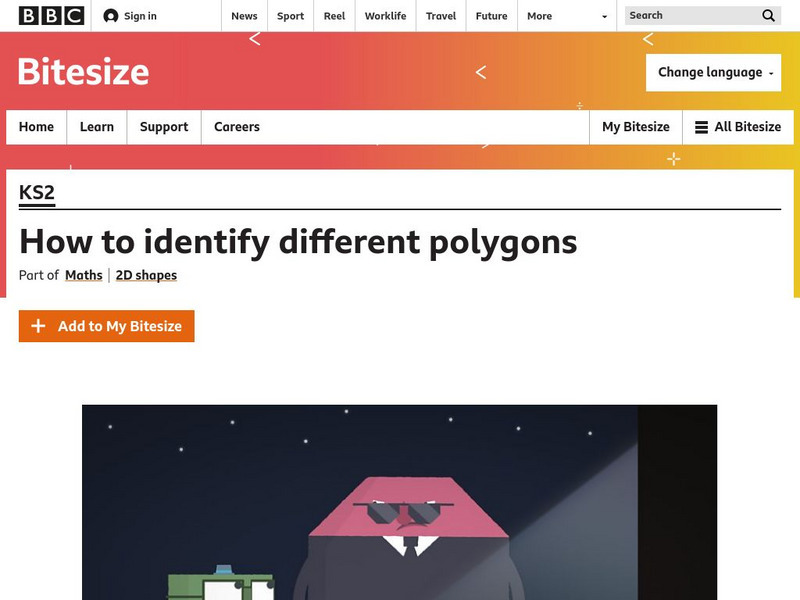Illustrative Mathematics
Illustrative Mathematics: 4.g What Shape Am I?
In this task, students ultimately use the definitions they are given for three types of quadrilaterals and what they know about parallel sides to identify that a square fits all the definitions and explain why. Aligns with 4.G.A.2.
Better Lesson
Better Lesson: Partitioning Rectangles and Squares
This site provides six practice activities to learn how to partition a rectangle into rows and columns of same-size squares and count to find the total number of them.
CK-12 Foundation
Ck 12: Elem Math: Identifying Rectangles, Squares, Circles, and Triangles
[Free Registration/Login may be required to access all resource tools.] The video discusses a brief overview of circles, rectangles, squares, and triangles and helps students determine which shape is shown and why. The video is followed...
CK-12 Foundation
Ck 12: Geometry: Area and Perimeter of Rectangles
[Free Registration/Login may be required to access all resource tools.] In this lesson, students find the perimeter and area of squares and rectangles by using formulas. Students examine guided notes, review guided practice, watch...
BBC
Bbc: Bitesize: Maths: 2 D Shapes
Learn about the properties of 2-D shapes: circles, triangles, polygons, and quadrilaterals. Includes information, video, and examples about each, with games and quizzes for reinforcement.
Rice University
Rice University: Cynthia Lanius: Golden Ratio
This site introduces students to the definition of golden ratio. It gives them a chance to estimate ratios and predict which figures are closest to the golden ratio. There is a link on this page that provides charts for students to...
Rice University
Rice University: Cynthia Lanius: Golden Rectangles All Around
This site is a lab sheet that students can use to explore the golden ratio. It also has other informative links on it.
Alabama Learning Exchange
Alex: Swimming Pool Math
Young scholars will use a swimming pool example to practice finding perimeter and area of different rectangles.
PBS
Pbs Kids: Dinosaur Train Track Star
Build a train by dragging shapes into a rectangle. Choose your level from easy (outline of shapes given) to hard (no outline of shapes).
National Council of Teachers of Mathematics
Nctm: Illuminations: Fraction and Percent Tool
This tool allows you to explore fractions, decimals and percents by creating fractions with denominators up to 100.
Geometry Help
Geometry Help: Rectangles
Explains the basic concept of a rectangle with step-by-step instructions and methods for solving specific problems on your own relating to this topic.
Math Open Reference
Math Open Reference: Rectangle
Learn about rectangles with this helpful reference tool. Provides a detailed definition, examples, and interactive activities that enhance further explanation. Includes links to related topics.
OER Commons
Oer Commons: Characteristics of Parallelograms
In this lesson, students learn more about the characteristics of parallelograms by folding paper and measuring the angles in a parallelogram. Students use a ruler and protractor to draw parallelograms with given properties. Then,...
CK-12 Foundation
Ck 12: Interactive Geometry: 4.7 Theorems About Quadrilaterals
Use quadrilateral properties that are unique to parallelograms to prove that the given shape is a parallelogram.
Quia
Ixl Learning: Rectangles
Brush up on your math skills relating to rectangles then try some practice problems to test your understanding.
Quia
Ixl Learning: Parallelograms
Brush up on your math skills pertaining to parallelograms then try some practice problems to test your understanding.
PBS
Pbs Learning Media: Shapes: Peg + Cat
We are learning about how shape attributes helps us to see how shapes are alike and different. This site provides four resources for shapes including 3-D.
Better Lesson
Better Lesson: Equivalent Numerical Expressions, Day 2 of 2
How can you represent the area of a diagram using numerical expressions? Students connect their knowledge of area and equivalent expressions to the commutative and distributive properties for day 2 of this investigation.
Better Lesson
Better Lesson: Equivalent Numerical Expressions, Day 1 of 2
How can you represent the area of a diagram using numerical expressions? Students apply their knowledge of area and order of operations to match area diagrams with numerical expressions.
Other
Nearpod: 2 D Shapes
In this instructional activity on 2D shapes, 3rd graders will learn to discriminate quadrilaterals from other polygons. Additionally, they will be able to identify attributes of a square, rectangle, and rhombus.
Other
Nearpod: Perimeters of Polygons
In this lesson on finding the perimeter of rectangles, 3rd graders learn key vocabulary, explore grid paper, and apply their learning to a real-world situation.
Other
Nearpod: Special Quadrilaterals
In this lesson on special quadrilaterals, 3rd graders learn key vocabulary, explore right angles and equal side lengths, and apply their learning to a real-world scenario.
Other
Nearpod: Area & Perimeter: Rectangle
In this lesson on area and perimeter, 3rd graders will learn how to find the area and perimeter of rectangles by applying formulas.
National Council of Teachers of Mathematics
The Math Forum: Suzanne Alejandre: Factor Lesson
Young scholars will discover factoring through the area of a rectangle.












